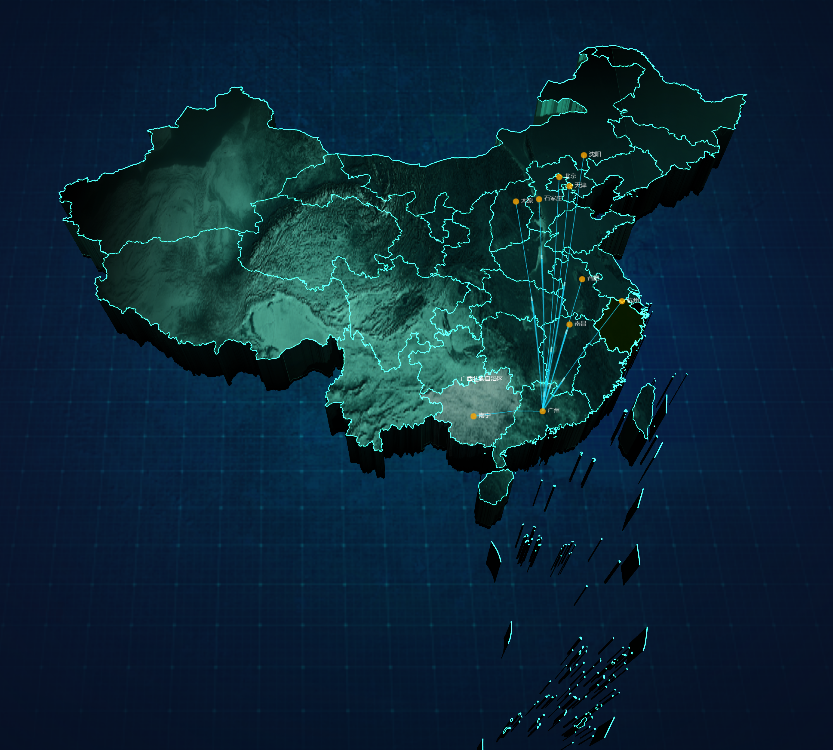前言
在现代数据可视化领域,3D 地图飞线效果是一种非常吸引人的展示方式,特别适合展示地理空间关系和数据流动。本文将详细解析如何使用 ECharts GL 在 Vue 项目中实现一个 3D 中国地图飞线效果。

技术栈
Vue.js 2.x/3.x
ECharts 5.x
ECharts GL 2.x
核心实现步骤
1. 准备工作
首先需要安装必要的依赖:
npm install echarts echarts-gl --save2. 基础地图配置
import * as echarts from 'echarts'
import "echarts-gl";
import chinaJson from '@/utils/chinaOutline.json'
export default {
mounted() {
this.initChart()
},
methods: {
initChart() {
const dom = this.$refs.chartRef;
this.myChart = echarts.init(dom);
echarts.registerMap('china', chinaJson);
// ...其他配置
}
}
}3. 数据处理
我们需要准备两类数据:
城市点位数据 - 用于在地图上显示城市位置
飞线数据 - 用于显示从起点到各城市的连线
const FROMCITY = [113.28064, 23.125177] // 起点坐标(深圳)
const FROMCITYCOORD = [113.28064, 23.125177]
// 处理飞线数据
const linesData = this.cityList.map(city => ({
fromName: FROMCITY,
toName: city.city,
coords: [
[FROMCITYCOORD[0], FROMCITYCOORD[1], 1],
[city.provinceCapitalX, city.provinceCapitalY, 1]
],
}));
// 处理散点数据
const scatterData = this.cityList.map(city => ({
name: city.city.replace('市', ''),
value: [city.provinceCapitalX, city.provinceCapitalY, 1],
}));4. 3D 地图核心配置
geo3D: {
map: 'china',
regionHeight: 8, // 区域高度
itemStyle: {
color: 'RGBA(153, 249, 235, 1)', // 地图基础颜色
borderWidth: 1.5
},
viewControl: {
distance: 110, // 观察距离
alpha: 60, // 上下旋转角度
beta: 0 // 左右旋转角度
},
// ...其他配置
}5. 飞线系列配置
{
type: 'lines3D',
effect: {
show: true,
period: 4, // 动画周期
trailWidth: 4, // 尾迹宽度
symbol: 'arrow', // 箭头符号
color: 'rgba(255,255,255, 1)'
},
lineStyle: {
width: 1.5,
color: '#1AD9FF', // 飞线颜色
opacity: 0.8
},
data: linesData // 飞线数据
}6. 城市点位配置
{
type: 'scatter3D',
symbol: 'circle',
symbolSize: 14,
label: {
show: true,
formatter: '{b}', // 显示城市名称
color: '#FFF'
},
itemStyle: {
color: '#FFA601' // 点颜色
},
data: scatterData // 散点数据
}完整代码解析
setChartInit() {
const dom = this.$refs.chartRef;
this.myChart = this.myChart || echarts.init(dom);
// 注册地图
echarts.registerMap('china', chinaJson);
// 准备数据
const linesData = this.cityList.map(city => ({
fromName: FROMCITY,
toName: city.city,
coords: [
[FROMCITYCOORD[0], FROMCITYCOORD[1], 1],
[city.provinceCapitalX, city.provinceCapitalY, 1]
],
}));
const scatterData = this.cityList.map(city => ({
name: city.city.replace('市', ''),
value: [city.provinceCapitalX, city.provinceCapitalY, 1],
}));
// 配置项
const option = {
// 3D地图配置
geo3D: {
map: 'china',
regionHeight: 8,
// ...其他geo3D配置
},
series: [
// 飞线系列
{
type: 'lines3D',
// ...飞线配置
data: linesData
},
// 点位系列
{
type: 'scatter3D',
// ...点位配置
data: scatterData
}
]
};
this.myChart.setOption(option);
}完整代码
<template>
<div class="chartRef" ref="chartRef" style="height: 100%;width: 100%" />
</template>
<script>
import * as echarts from 'echarts'
import '@/utils/chinaMap'
import "echarts-gl";
import chinaJson from '@/utils/chinaOutline.json'
const FROMCITY = [113.28064, 23.125177]
const FROMCITYCOORD = [113.28064, 23.125177]
export default {
name: 'Demo',
data() {
return {
cityList:[
{
"id": 0,
"city": "绍兴市",
"provinceCapitalX": "120.15358",
"provinceCapitalY": "30.287458",
"num": 200
},
{
"id": 1,
"city": "北京市",
"provinceCapitalX": "116.405289",
"provinceCapitalY": "39.904987",
"num": 200
},
{
"id": 2,
"city": "嘉兴市",
"provinceCapitalX": "120.15358",
"provinceCapitalY": "30.287458",
"num": 200
},
{
"id": 3,
"city": "锦州市",
"provinceCapitalX": "118.76741",
"provinceCapitalY": "41.796768",
"num": 200
},
{
"id": 4,
"city": "临沂市",
"provinceCapitalX": "120.15358",
"provinceCapitalY": "30.287458",
"num": 200
},
{
"id": 5,
"city": "深圳市",
"provinceCapitalX": "113.28064",
"provinceCapitalY": "23.125177",
"num": 200
}
],
}
},
mounted() {
this.getData()
},
watch: {
},
methods: {
// 地图组件初始加载
setChartInit() {
const dom = this.$refs.chartRef;
this.myChart = this.myChart || echarts.init(dom);
echarts.registerMap('china', chinaJson);
const linesData = this.cityList.map(city => ({
fromName: FROMCITY,
toName: city.city,
coords: [[FROMCITYCOORD[0], FROMCITYCOORD[1], 1], [city.provinceCapitalX, city.provinceCapitalY, 1]],
}));
const scatterData = this.cityList.map(city => ({
name: city.city.replace('市', ''),
value: [city.provinceCapitalX, city.provinceCapitalY, 1],
}));
const option = {
tooltip: {
trigger: 'axis',
axisPointer: {
type: 'shadow'
}
},
backgroundColor: 'transparent',
geo3D: {
zlevel: 1,
type: 'geo3D',
coordinateSystem: 'geo3D',
map: 'china',
regionHeight: 8,
roam: false,
silent: false,
select: {
disabled: false
},
itemStyle: {
borderColor: 'RGBA(37, 182, 144, 0)',
color: 'RGBA(153, 249, 235, 1)',
borderWidth: 1.5
},
shading: "realistic",
realisticMaterial: {
detailTexture: "./bg.png",
textureTiling: 1,
blendMode: 'Additive', // 可选值:Additive / Subtractive / Multiply 等
},
light: {
main: {
intensity: 1.2,
shadow: true,
shadowQuality: 'high'
},
ambient: {
intensity: 0.3
}
},
viewControl: {
distance: 110,
alpha: 60,
beta: 0,
autoRotate: false,
rotateSensitivity: 1,
zoomSensitivity: 1,
panSensitivity: 1
},
emphasis: {
label: {
show: true,
color: 'RGBA(255, 255, 255, 1)',
fontSize: 14,
},
itemStyle: {
color: 'RGBA(255, 255, 255, 1)',
borderWidth: 4,
borderColor: "RGBA(255,255,255, 1)",
regionHeight: 25,
opacity: 1,
shadowColor: 'RGBA(153, 249, 235, 1)'
}
},
},
series: [
// 飞线系列
{
type: 'lines3D',
coordinateSystem: 'geo3D',
zlevel: 2,
silent: true,
effect: {
show: true,
period: 4,
trailWidth: 4,
trailLength: 0.4,
symbol: 'arrow',
symbolSize: 16,
color: 'rgba(255,255,255, 1)'
},
lineStyle: {
width: 1.5,
color: '#1AD9FF',
opacity: 0.8
},
data: linesData
},
// 点位系列
{
type: 'scatter3D',
coordinateSystem: 'geo3D',
zlevel: 3,
symbol: 'circle',
symbolSize: 14,
silent: false,
label: {
show: true,
position: 'right',
formatter: '{b}',
textStyle: {
color: '#FFF',
fontSize: 14
}
},
itemStyle: {
color: '#FFA601'
},
emphasis: {
label: {
show: false
},
itemStyle: {
color: '#1AD9FF'
}
},
data: scatterData
}
]
}
this.myChart.setOption(option);
}
}
}
</script>
<style scoped lang="scss">
</style>
效果优化技巧
动画效果:通过调整
effect.period可以改变飞线动画速度视觉层次:使用
zlevel控制不同图层的叠加顺序光照效果:调整
light配置可以改变地图的明暗效果交互体验:配置
viewControl可以控制地图的旋转、缩放等交互行为
常见问题解决
地图不显示:
确保正确注册了地图 JSON 数据
检查容器是否有固定宽高
飞线不显示:
检查坐标数据格式是否正确
确保 lines3D 系列被正确添加到 series 中
性能问题:
数据量过大时考虑简化或聚合数据
使用
silent: true减少不必要的交互检测
总结
通过 ECharts GL 实现 3D 地图飞线效果,可以为地理空间数据提供更加直观的展示方式。本文详细介绍了从数据准备到最终实现的完整流程,以及各种配置项的用途和优化技巧。这种可视化方式特别适合展示城市间的关联关系、物流路线、人口迁移等场景。
希望这篇技术解析能帮助你在项目中实现类似的效果。如果有任何问题,欢迎在评论区讨论。